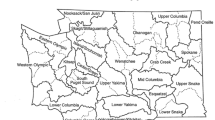Abstract
Stream and watershed management and restoration can be greatly facilitated through use of physiographic landform classification to organize and communicate natural resource, hazard, and environmental information at a broad scale (1:250,000) as illustrated by the Piedmont and Coastal Plain Provinces in Maryland, or at a small scale (1:24,000) as illustrated using divisions and zones combined with a conceptual model. The conceptual model brings together geology, surficial processes, landforms and land use change information at the small watershed scale and facilitates transfer of information from one small watershed to another with similar geology and landforms. Stream flow, sediment erosion, and water quality illustrate the use of the model.






Similar content being viewed by others
References
Cleaves ET (1974) Landform map. In: Cleaves ET, Crowley WP, Kuff KR (eds) Towson Quadrangle geologic and environmental atlas. Maryland Geological Survey, Baltimore, MD
Cleaves ET (1979) Physiographic map of the White Marsh quadrangle. In: Cleaves ET, Kuff KR, Otton EG, Crowley WP, Reinhardt J (eds) White Marsh quadrangle: geology, hydrology, and mineral resources. Maryland Geological Survey, Baltimore, Quadrangle Atlas No 4, map 2
Cleaves ET (2000) Landscape classification for suburban planning. Bol R Soc Esp Hist Nat (Sec Geol) 96(1–2):47–56
Cleaves ET, Fisher DW, Bricker OP (1974) Chemical weathering of serpentinite in the Eastern Piedmont of Maryland. Geol Soc Am Bull 83:437–444
Cleaves ET, Godfrey AE, Bricker OP (1970) Geochemical balance of a small watershed and its geomorphic implications. Geol Soc Am Bull 81:3013–3032
Costa JC (1973) Geomorphic evolution and environmental geology of Western Run watershed, Baltimore, Maryland. PhD Thesis, Johns Hopkins University, Baltimore, MD, 206 pp
Ferguson BK, Suckling PW (1990) Changing rainfall—runoff relationship in the urbanizing Peachtree Creek watershed, Atlanta, Georgia. Am Water Resour Assoc, Water Resour Bull 26:313–322
Godfrey AE, Cleaves ET (1991) Landscape analysis: theoretical considerations and practical needs. Environ Geol Water Sci 17(2):141–155
Leopold LB (1978) Hydrology for urban land planning: a guidebook on the hydrologic effects of urban land use. USGS Circular 554, 17 pp
O’Bryan D, McAvoy RL (1966) Gunpowder Falls, Maryland. USGS, Water-Supply Paper 1815, 90 pp
Omernik JM, Bailey RG (1997) Distinguishing between watersheds and ecoregions. J Am Water Resour Assoc 33(5):935–949
Reger J, Cleaves ET, (2003) Physiographic map of Maryland (1:250,000). Maryland Geological Survey, Baltimore (in preparation)
White JS, Bowman ML, Stribling JB (1998) Subregionalization of Maryland’s Mid-Atlantic Coastal Plain Ecoregion as a technique for linking watersheds, scale 1:250,000. Tetra Tech, Owings Mills, MD
Wolman MG (1964) Problems posed by sediment derived from construction activities in Maryland. Report to Maryland Water Pollution Control Commission, Annapolis, MD, 125 pp
Yorke TH, Herb WJ (1978) Effects of urbanization on stream flow and sediment transport in the Rock Creek and Anacostia River Basins, Montgomery County, Maryland, 1962–1964. USGS, Professional Paper 1003, 71 pp
Acknowledgements
The concepts and ideas in this article have greatly benefited from the thoughtful and critical scrutiny of my reviewers: Andrew E. Godfrey, US Forest Service, Pixie Hamilton and John Costa, US Geological Survey, and José Martin, Departmento de Geodinamica, Universidad Complutense de Madrid.
Author information
Authors and Affiliations
Corresponding author
Rights and permissions
About this article
Cite this article
Cleaves, E.T. Conceptual model for transferring information between small watersheds. Env Geol 45, 190–197 (2003). https://doi.org/10.1007/s00254-003-0872-4
Received:
Accepted:
Published:
Issue Date:
DOI: https://doi.org/10.1007/s00254-003-0872-4




